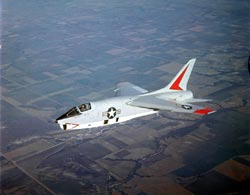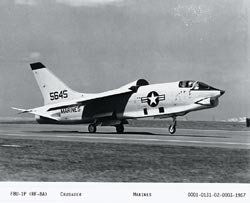|
 At virtually the same time as the final design program was underway on the production version of the F8U-1 at the Vought plant in Dallas, a parallel design was initiated for a photo-reconnaissance version of the aircraft. The photo Crusader was, from the wing leading edge aft, essentially the same as the fighter version. The nose section and the forward portion of the mid section were redesigned to remove all armament provisions and all fire-control systems and replace them with camera stations and night photo flare pods, along with all the control systems associated with their operation. At virtually the same time as the final design program was underway on the production version of the F8U-1 at the Vought plant in Dallas, a parallel design was initiated for a photo-reconnaissance version of the aircraft. The photo Crusader was, from the wing leading edge aft, essentially the same as the fighter version. The nose section and the forward portion of the mid section were redesigned to remove all armament provisions and all fire-control systems and replace them with camera stations and night photo flare pods, along with all the control systems associated with their operation.
The sides and bottom of the fuselage were “squared off” to provide flat surfaces for the electrically heated optical glass windows required for the desired photographic quality. These flat surfaces were then faired into existing contour around the air duct inlet, the nose cone and the canopy enclosure, and into the fuselage mid section at the forward end of the main landing gear wells. The “area rule” concept was applied to this new configuration, which resulted in a slight bump on the top surface of the fuselage aft of the canopy and extending over the top of the forward portion of the wing. This re-contouring of the fuselage allowed the inflight refueling probe to be completely submerged into the fuselage and covered with a flush door, eliminating the blister door used on the fighter.
 Camera Station 1 was located on the lower surface below the cockpit and forward of the nose landing gear well. A small “bump” was faired around a slanted forward-looking optical window. The station mounted an oblique camera which photographed the aircraft’s flight path on a 16-mm movie camera. The original concept called for Camera Station 2, actually the aft-most bay, to mount three trimetrogen cameras, providing horizon-to-horizon coverage. With experience and experimentation, a more common array of cameras was developed. Stations 3 and 4, the middle bays, mounted two cameras giving vertical and oblique coverage. The most common angles of obliquity used were 5, 15 and 30. The cameras selected by the Navy were manufactured and furnished by Chicago Aerial and were designated as the KA-66 used at Station 2, KA-51, -53 and -62 at Stations 3 and 4, and KA-45 or -51 at Station 1. In the later life of the photo Crusader, another oblique forward looking camera was mounted at Station 1 which took continuous photos of approaches to targets in Viet Nam. These photos were used by bomber pilots to familiarize themselves with the terrain they would encounter in upcoming missions. Camera Station 1 was located on the lower surface below the cockpit and forward of the nose landing gear well. A small “bump” was faired around a slanted forward-looking optical window. The station mounted an oblique camera which photographed the aircraft’s flight path on a 16-mm movie camera. The original concept called for Camera Station 2, actually the aft-most bay, to mount three trimetrogen cameras, providing horizon-to-horizon coverage. With experience and experimentation, a more common array of cameras was developed. Stations 3 and 4, the middle bays, mounted two cameras giving vertical and oblique coverage. The most common angles of obliquity used were 5, 15 and 30. The cameras selected by the Navy were manufactured and furnished by Chicago Aerial and were designated as the KA-66 used at Station 2, KA-51, -53 and -62 at Stations 3 and 4, and KA-45 or -51 at Station 1. In the later life of the photo Crusader, another oblique forward looking camera was mounted at Station 1 which took continuous photos of approaches to targets in Viet Nam. These photos were used by bomber pilots to familiarize themselves with the terrain they would encounter in upcoming missions.
The prototype of the F8U-1P was originally built as the 32nd production F8U-1, BuNo 141363, and after modification to the photo configuration it made its initial flight on 17 December 1957. Following a short test program to verify all operating systems that were unique to the photo Crusader, the aircraft was delivered to the Navy and served its entire life as a photo- recce Crusader.
The F8U-1P photo reconnaissance version of the Crusader was the aircraft in which Major John Glenn set a transcontinental speed record (Mach 1.1 average speed) in 1957. The F8U-1P served in the fleet long after the fighter version was retired.
F8U:
XF8U-1 Innovative Systems
XF8U-1 In The Cockpit
A New Aircraft and a New Coporation
F8U-1 and F8U-1E production Aircraft Changes
Life Extension
Loss of F8U-3 and a New Challenge
Last flight of the F8 (1999)
|